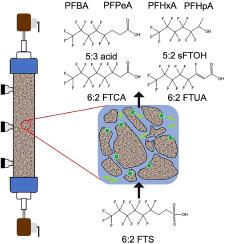当前位置:
X-MOL 学术
›
Water Res.
›
论文详情
Our official English website, www.x-mol.net, welcomes your
feedback! (Note: you will need to create a separate account there.)
Biotransformation of 6:2 fluorotelomer sulfonate and microbial community dynamics in water-saturated one-dimensional flow-through columns
Water Research ( IF 11.4 ) Pub Date : 2024-01-15 , DOI: 10.1016/j.watres.2024.121146
Peng-Fei Yan 1 , Sheng Dong 1 , Matthew J Woodcock 2 , Katherine E Manz 3 , Uriel Garza-Rubalcava 2 , Linda M Abriola 2 , Kurt D Pennell 2 , Natalie L Cápiro 1
Water Research ( IF 11.4 ) Pub Date : 2024-01-15 , DOI: 10.1016/j.watres.2024.121146
Peng-Fei Yan 1 , Sheng Dong 1 , Matthew J Woodcock 2 , Katherine E Manz 3 , Uriel Garza-Rubalcava 2 , Linda M Abriola 2 , Kurt D Pennell 2 , Natalie L Cápiro 1
Affiliation

|
Nearly all per- and polyfluoroalkyl substances (PFAS) biotransformation studies reported to date have been limited to laboratory-scale batch reactors. The fate and transport of PFAS in systems that more closely represent field conditions, i.e., in saturated porous media under flowing conditions, remain largely unexplored. This study investigated the biotransformation of 6:2 fluorotelomer sulfonate (6:2 FTS), a representative PFAS of widespread environmental occurrence, in one-dimensional water-saturated flow-through columns packed with soil obtained from a PFAS-contaminated site. The 305-day column experiments demonstrated that 6:2 FTS biotransformation was rate-limited, where a decrease in pore-water velocity from 3.7 to 2.4 cm/day, resulted in a 21.7–26.1 % decrease in effluent concentrations of 6:2 FTS and higher yields (1.0–1.4 mol% vs. 0.3 mol%) of late-stage biotransformation products (C4 7 perfluoroalkyl carboxylates). Flow interruptions (2 and 7 days) were found to enhance 6:2 FTS biotransformation during the 6–7 pore volumes following flow resumption. Model-fitted 6:2 FTS column biotransformation rates (0.039–0.041 cm w 3 / g s / d cm w 3 / g s / d Pseudomonas dominated in planktonic microbial communities, while in the attached microbial communities, Rhodococcus decreased and Pelotomaculum increased along the flow path, suggesting their potential involvement in early- and late-stage 6:2 FTS biotransformation, respectively. Overall, this study highlights the importance of incorporating realistic environmental conditions into experimental systems to obtain a more representative assessment of in-situ PFAS biotransformation.
中文翻译:

6:2 含氟调聚物磺酸盐的生物转化和微生物群落在水饱和的一维流通柱中的作用
迄今为止报道的几乎所有全氟烷基和多氟烷基物质 (PFAS) 生物转化研究都仅限于实验室规模的间歇式反应器。PFAS 在更能代表现场条件的系统中(即在流动条件下的饱和多孔介质中)的归宿和运输在很大程度上仍未得到探索。本研究调查了 6:2 氟调聚物磺酸盐 (6:2 FTS)(一种具有广泛环境影响的代表性 PFAS)在一维水饱和流通柱中的生物转化,该柱填充有从 PFAS 污染场地获得的土壤。305 天的塔实验表明,6:2 FTS 生物转化速率有限,其中孔隙水速度从 3.7 cm/天降低到 2.4 cm/天,导致 6:2 FTS 的出水浓度降低 21.7-26.1%,后期生物转化产物(C4C7 全氟烷基羧酸盐)的产量更高(1.0-1.4 mol% vs. 0.3 mol%)。发现血流中断(2 天和 7 天)在血流恢复后 6-7 个孔体积期间增强了 6:2 FTS 生物转化。模型拟合的 6:2 FTS 色谱柱生物转化率 (0.039–0.041 cmw3/gs/d) 比在微观世界中观察到的生物转化率 (0.137 cmw3/gs/d) 小 ∼3.5 倍。此外,在色谱柱实验期间,浮游微生物群落保持相对稳定,而附着的微生物群落的组成沿流路移动,这可能归因于氧气可用性以及 6:2 FTS 和相关生物转化产物的毒性。 假单胞菌属在浮游微生物群落中占主导地位,而在附着的微生物群落中,红球菌沿流路减少,Pelotomaculum 增加,表明它们分别可能参与早期和晚期 6:2 FTS 生物转化。总体而言,本研究强调了将现实环境条件纳入实验系统的重要性,以获得对原位 PFAS 生物转化的更具代表性的评估。
更新日期:2024-01-15
中文翻译:

6:2 含氟调聚物磺酸盐的生物转化和微生物群落在水饱和的一维流通柱中的作用
迄今为止报道的几乎所有全氟烷基和多氟烷基物质 (PFAS) 生物转化研究都仅限于实验室规模的间歇式反应器。PFAS 在更能代表现场条件的系统中(即在流动条件下的饱和多孔介质中)的归宿和运输在很大程度上仍未得到探索。本研究调查了 6:2 氟调聚物磺酸盐 (6:2 FTS)(一种具有广泛环境影响的代表性 PFAS)在一维水饱和流通柱中的生物转化,该柱填充有从 PFAS 污染场地获得的土壤。305 天的塔实验表明,6:2 FTS 生物转化速率有限,其中孔隙水速度从 3.7 cm/天降低到 2.4 cm/天,导致 6:2 FTS 的出水浓度降低 21.7-26.1%,后期生物转化产物(C4C7 全氟烷基羧酸盐)的产量更高(1.0-1.4 mol% vs. 0.3 mol%)。发现血流中断(2 天和 7 天)在血流恢复后 6-7 个孔体积期间增强了 6:2 FTS 生物转化。模型拟合的 6:2 FTS 色谱柱生物转化率 (0.039–0.041 cmw3/gs/d) 比在微观世界中观察到的生物转化率 (0.137 cmw3/gs/d) 小 ∼3.5 倍。此外,在色谱柱实验期间,浮游微生物群落保持相对稳定,而附着的微生物群落的组成沿流路移动,这可能归因于氧气可用性以及 6:2 FTS 和相关生物转化产物的毒性。 假单胞菌属在浮游微生物群落中占主导地位,而在附着的微生物群落中,红球菌沿流路减少,Pelotomaculum 增加,表明它们分别可能参与早期和晚期 6:2 FTS 生物转化。总体而言,本研究强调了将现实环境条件纳入实验系统的重要性,以获得对原位 PFAS 生物转化的更具代表性的评估。

































 京公网安备 11010802027423号
京公网安备 11010802027423号